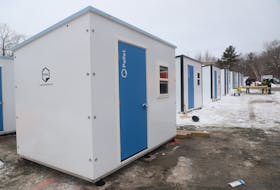When hurricane Arthur became post-tropical storm Arthur early July 5, he didn’t settle down much.
The first named storm of the Atlantic hurricane season had gusts of 120 km/h as a hurricane and 110 km/h or more after its transformation. The high winds knocked down trees and power lines throughout the western end of the province, with thousands of Nova Scotia Power customers without electricity, including large outages through the Annapolis Valley and the Digby and Clare area. At 2 p.m. July 6, there were more than 22,000 customers without power in Kings County, 6,300 in Annapolis County and almost 12,000 out in the Digby area.
According to the Canadian Hurricane Centre, the storm merged with a cold front, similar to what happened with hurricane Igor hit Newfoundland four years ago.
“When a hurricane becomes a post-tropical storm, it is not always a ‘downgrade,’” the July 6 summary from the centre noted. “In fact, when these storms undergo the transformation to post-tropical status, the area of high winds (and rain) expands signifincantly.”
Instead of diminishing, the storm’s energy spread out, battering most of the Maritimes for more than 24 hours.
More stories and photos from western Nova Scotia here and get up-to-date information the TC Media live blog.
Strong winds continued long after the centre of Arthur reached land near Meteghan, Digby County, at breakfast time morning as a strong post-tropical storm.
By supper Saturday, winds were still rocking the Valley area. Greenwood, Kings County, recorded a gust of 138 km/h in the early evening.
What affected western Nova Scotia was a “sting jet,” the CHC says, or strong winds just left, or west, of the storm’s centre.
Arthur was “exceptional” in how much of an effect the northwest winds had, both in the Fredericton area and the Valley, the centre said
Maximum wind gusts in km/h
Greenwood 138
Brier Island 128
Five Islands 127
Yarmouth 111
Lunenburg 108
Charlottetown 105
Fredericton 100
Power outages as of 5:45 p.m. July 6
Bridgetown (5631)Bridgewater (10992)Caledonia (1892)Clare (3852)Digby (8737)Kentville/Wolfville (10983)Kingston (8590)Liverpool (2295)Pubnico (832)Shelburne (3097)Yarmouth (3805)Amherst/North Shore (772)Bedford/Sackville (148)Chester (1333)Oxford/Pugwash (483)Parrsboro/Springhill/Noel Shore (881)Tatamagouche/Wentworth Valley (1972)Truro (779)Windsor (9315)New Glasgow/Pictou County (2935)
When hurricane Arthur became post-tropical storm Arthur early July 5, he didn’t settle down much.
The first named storm of the Atlantic hurricane season had gusts of 120 km/h as a hurricane and 110 km/h or more after its transformation. The high winds knocked down trees and power lines throughout the western end of the province, with thousands of Nova Scotia Power customers without electricity, including large outages through the Annapolis Valley and the Digby and Clare area. At 2 p.m. July 6, there were more than 22,000 customers without power in Kings County, 6,300 in Annapolis County and almost 12,000 out in the Digby area.
According to the Canadian Hurricane Centre, the storm merged with a cold front, similar to what happened with hurricane Igor hit Newfoundland four years ago.
“When a hurricane becomes a post-tropical storm, it is not always a ‘downgrade,’” the July 6 summary from the centre noted. “In fact, when these storms undergo the transformation to post-tropical status, the area of high winds (and rain) expands signifincantly.”
Instead of diminishing, the storm’s energy spread out, battering most of the Maritimes for more than 24 hours.
More stories and photos from western Nova Scotia here and get up-to-date information the TC Media live blog.
Strong winds continued long after the centre of Arthur reached land near Meteghan, Digby County, at breakfast time morning as a strong post-tropical storm.
By supper Saturday, winds were still rocking the Valley area. Greenwood, Kings County, recorded a gust of 138 km/h in the early evening.
What affected western Nova Scotia was a “sting jet,” the CHC says, or strong winds just left, or west, of the storm’s centre.
Arthur was “exceptional” in how much of an effect the northwest winds had, both in the Fredericton area and the Valley, the centre said
Maximum wind gusts in km/h
Greenwood 138
Brier Island 128
Five Islands 127
Yarmouth 111
Lunenburg 108
Charlottetown 105
Fredericton 100
Power outages as of 5:45 p.m. July 6
Bridgetown (5631)Bridgewater (10992)Caledonia (1892)Clare (3852)Digby (8737)Kentville/Wolfville (10983)Kingston (8590)Liverpool (2295)Pubnico (832)Shelburne (3097)Yarmouth (3805)Amherst/North Shore (772)Bedford/Sackville (148)Chester (1333)Oxford/Pugwash (483)Parrsboro/Springhill/Noel Shore (881)Tatamagouche/Wentworth Valley (1972)Truro (779)Windsor (9315)New Glasgow/Pictou County (2935)








